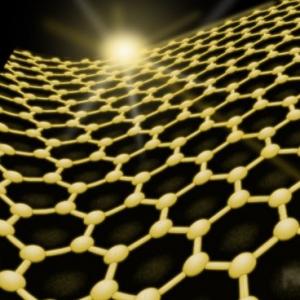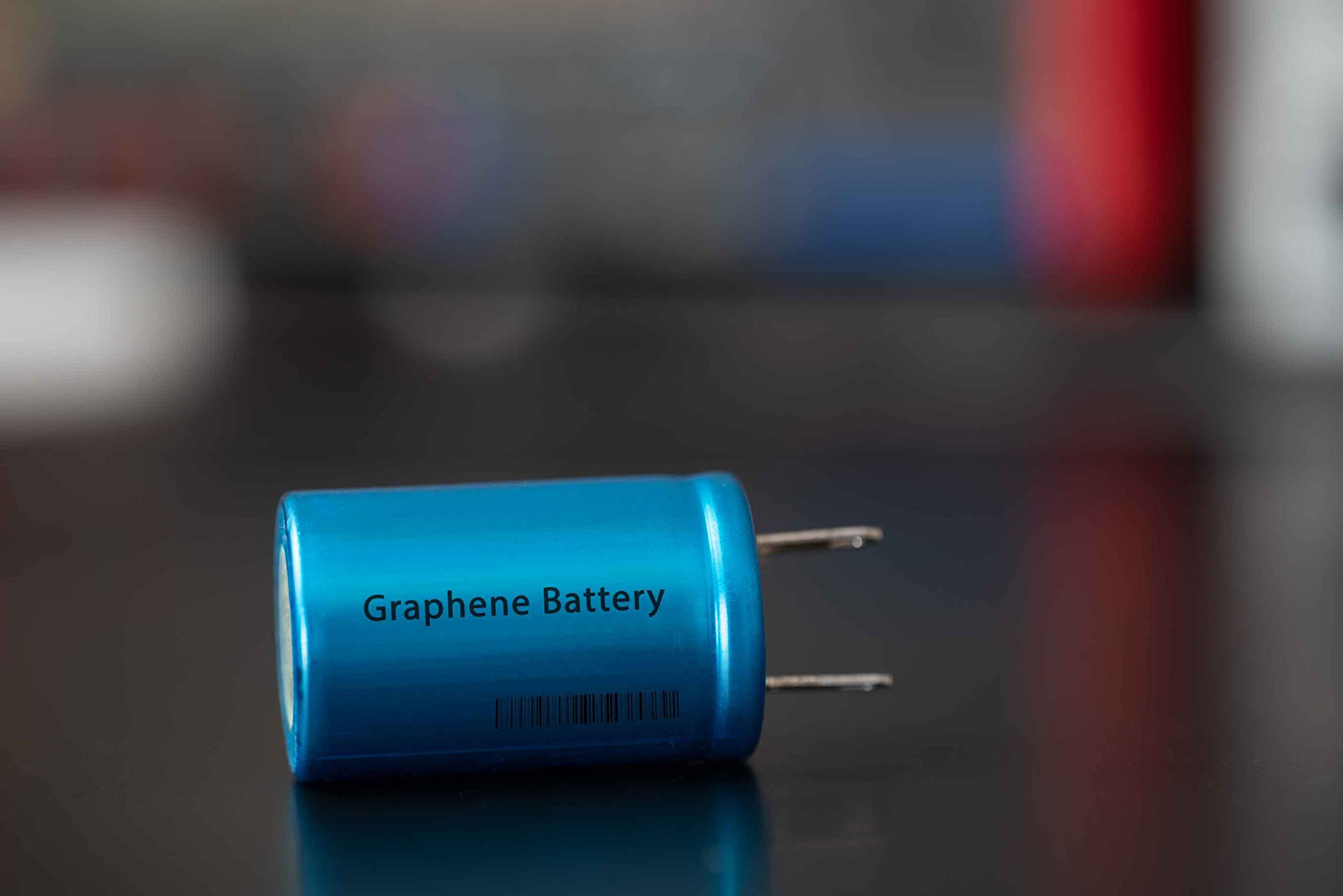Areas of Focus
Critical Materials and Processing
Critical Materials and Processing
Graphene is made of a single layer of carbon atoms that are bonded together in a repeating pattern of hexagons. It is a 2 dimensional material with amazing characteristics. It is extremely strong and almost entirely transparent and also astonishingly conductive and flexible. Graphene is made of carbon, which is abundant, and can be a relatively inexpensive material. Graphene has a seemingly endless potential for improving existing products as well as inspiring new ones.

Solar cells require materials that are conductive and allow light to get through, thus benefiting from graphene's superb conductivity and transparency. Graphene is indeed a great conductor, but it is not very good at collecting the electrical current produced inside the solar cell. Hence, researchers are looking for appropriate ways to modify graphene for this purpose. Graphene Oxide (GO), for example, is less conductive but more transparent and a better charge collector which can be useful for solar panels.
The conductive Indium Tin Oxide (ITO) is used with a non-conductive glass layer as the transparent electrodes in most organic solar panels to achieve these goals, but ITO is rare, brittle and makes solar panels expensive. Many researches focus on graphene as a replacement for ITO in transparent electrodes of OPVs. Others search for ways of utilizing graphene in improving overall performance of photovoltaic devices, mainly OPVs, as well as in electrodes, active layers, interfacial layers and electron acceptors

Graphene is being researched for use in lenses, particularly smart contact lenses, to provide functions like electromagnetic interference (EMI) shielding, dehydration prevention, and infrared vision. Our Researchers are exploring how graphene's unique properties—such as its strength, conductivity, and transparency—can be used to create advanced optics for healthcare and augmented reality applications.
Key applications and properties

In today’s increasingly electrified and wirelessly connected world, the demand for improved energy storage continues to grow. In particular, electric cars and mobile applications require high-energy density and high-power density storage devices for extended range and rapid charging.
Novel battery and super-capacitor technologies are being developed to address these needs, based on new technology designs and novel materials. Graphene has the potential to influence both battery and super-capacitor devices.
Plaid Technologies Inc, Is testing Graphene Due to its high aspect ratio, easily dispersed, high conductivity graphene platelets which are ideal electrode additives for batteries and super-capacitors.
Plaid Technologies continues to develop and evaluate new material opportunities in graphene energy storage devices.

Aerospace engineers are looking at graphene and other advanced materials as key enabling technologies for the next generation of aircraft and space vehicles. The ability to produce structures and devices that are lighter, stronger, more resilient, use less energy and that have new capabilities can only happen if we have a new class of materials with which to build these next generation objects.
In addition, the trend in aerospace engineering is to increase the functionality of parts so that they solve several problems at the same time. Engineers have achieved this progress, for example, by either modifying the polymer matrix or adding a multifunctional coating that incorporates graphene.
Currently, carbon fiber reinforced polymers (CFRP) parts have become the mainstay material in aerospace components, including fuselages, leading edge and wing surfaces to provide lightweight, high strength and corrosion resistance.
However, today graphene-enabled structures can provide a degree of weight savings by improving CFRP in terms of strength-to-weight ratio. In addition, graphene-enabled parts also bring much more functionality. For instance, graphene’s electrical conductivity can provide a way for mitigating lightning strikes and also for embedding electronics, such as sensors, into the structure of the aircraft.
Graphene can help realize the visions of aerospace engineers in which there will be no need for wires to be strung through an aircraft, they will all be embedded into its various structures. And the aircraft will be entirely self-diagnostic; with sensors embedded throughout the graphene-enabled polymers it will be possible to detect in the minutest detail the stresses and strain that are developing on the aircraft.
Graphene is not just a theoretical material of the future but is already offering significant benefits commercially in areas that are key or that can be modified for the aerospace sector. As can be seen from the diagram, there are multiple systems, parts and applications that can and will benefit from graphene.
Graphene has extraordinary properties, making it attractive for a wide range of applications—Graphene’s strength, flexibility, thermal and electrical conductivity, and its transparency give it characteristics far superior to many other materials that it is competing with in aerospace applications.
Graphene is on an accelerated developmental trajectory compared to carbon fiber in the aerospace industry—Carbon fiber was first introduced to the aerospace industry in the late 1960s, taking decades for the industry to fully adopt the material as it replaced heavier, and weaker aluminum. Graphene has been proven to make Carbon Fiber Reinforced Plastics (CFRPs) even lighter and stronger with greater impact resistance.
Graphene is poised to enable the expansion of functionality of critical aerospace parts—Aerospace designers and engineers are increasingly looking for various parts to perform different purposes. For instance, the material covering of a wing would ideally provide high strength and durability but be incredibly light. You would also want it be able to have electricity flow through it to de-ice the wings. Or with that same electricity you could power the sensors embedded in it to detect stresses put on it. Graphene has the highest strength-to-weight ratio of any material in the world. It is also an excellent conductor of electricity—better than copper—so electricity could also flow through it to de-ice a wing or run electronics through it.
The rapid growth of electric vehicles (EVs) is pushing the demand for more efficient, durable, and sustainable battery technologies. While lithium-ion (Li-ion) batteries have dominated the EV landscape, they have several limitations, including long charging times, degradation over multiple cycles, and safety concerns.
Graphene, a groundbreaking material known for its exceptional electrical and thermal properties, is emerging as a game-changer in battery technology. By integrating graphene into energy storage solutions, researchers and companies aim to significantly improve battery performance. This article examines graphene batteries' advantages, research progress, commercialization challenges, and impact on EVs.
Advantages of Graphene Batteries Over Li-Ion Batteries
Graphene-based batteries offer several advantages over conventional Li-ion batteries, making them highly promising for the EV industry.
Faster Charging: Graphene enables rapid electron movement, significantly reducing charging times. While Li-ion batteries take 30–60 minutes for a full charge, graphene batteries could potentially charge within a few minutes.1,2
Higher Energy Density: Li-ion batteries have a limited energy storage capacity. With their high surface area and superior conductivity, graphene batteries can store more energy in the same volume, extending the EV range.1,2
Longer Lifespan: Traditional batteries degrade with repeated charge cycles. Graphene batteries exhibit less wear and tear, resulting in a longer operational life and reducing the need for frequent replacements.1,2
Improved Efficiency: Graphene enhances ion transport, reducing energy losses during charging and discharging. This leads to better overall battery performance and improved vehicle efficiency.1,2
Enhanced Safety: Overheating and thermal runaway are common issues with Li-ion batteries. Graphene’s superior thermal conductivity dissipates heat efficiently, minimizing the risk of fires and explosions.

Graphene is a promising material for quantum computing due to its unique electronic and mechanical properties, which can be used to create and stabilize qubits, transmit quantum information efficiently, and build ultra-thin quantum circuits. Potential applications include creating robust topological qubits, developing novel spintronic devices to connect qubits, and improving components like single-photon detectors. Research is exploring ways to use graphene's ability to host exotic states of matter and to enable magnet-free quantum effects, paving the way for more powerful and efficient quantum computers.
How graphene is used in quantum computing
Qubit creation and stabilization:
Graphene's properties are being explored to create new types of qubits, the fundamental units of quantum information.
Researchers are investigating graphene nanotorus to encode qubits and use magnetic and electric fields to control them and reduce errors.
It can be used to create more stable topological qubits that are less susceptible to environmental interference.
Quantum information transfer:
Graphene's high electron mobility makes it ideal for creating spintronic devices that use electron spin to carry information.
Recent breakthroughs have demonstrated magnet-free spin currents in graphene, which could be used to efficiently link qubits together in a quantum circuit without needing large magnetic fields, notes SciTechDaily and ScienceDaily.
Integration and error reduction:
Graphene's high conductivity and minimal electrical noise can help reduce error rates in quantum calculations.
It has the potential to help integrate quantum computers with existing classical electronics.
Novel device applications:
Research has explored using graphene plasmons for quantum computing tasks.
Graphene's unique electronic properties are also being used to develop highly efficient single-photon detectors.